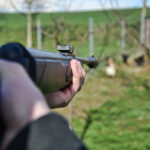The number one question people ask us at outdoor shows and in the field is “how do you set up your decoys” or “why did you set your goose decoys up this way”. In fact I’d say it’s the number one reason people who book a guided goose or duck hunt with Maxxed Out Guides want to learn about while they’re in the field.
Unfortunately there isn’t one easy answer. Some hunters may say they set up there spread one particular way every time. You’ll hear hunters talk about and X, C, J spread which means their decoys are set to loosely resemble one of those letters. I strongly recommend not following that line of thinking. There are many times driving around that I’ll see decoy spreads that make a definitive, C, J or X in the field.
This causes two problems for you. First birds don’t naturally sit in fields in formations that resemble letters. Second birds see these unnatural looking spreads up and down the flyway. So not only are they unnatural geese get trained and accustomed to seeing them. This is typically not a combination for success.
However from my experience there is no one decoy spread that each and every day in the field. Some days you need more decoys. Some days you need fewer. There are days where your blinds will need to be at the front of your decoy spread and there are some days where they will need to be at the back.
There are many variables to this equation but the main variable, as it is with any hunt, is the weather. Birds simply look for different things in different weather conditions. The only thing that can tell you how to react to weather is experience and time in the field.
Are there days that a ‘letter shaped” spread will kill geese? Absolutely! However what you typically find on those types of days is most any style spread will kill birds.
So while there isn’t one “go to” spread there are a few things that can help you as you learn how to set your decoys.
First is the kill hole. You always want to try and manipulate the birds to attempt land or finish where you want them. Usually the kill hole is a spot in front of everyone that will create safe shooting lanes and opportunity for everyone to shoot. Typically we like to set up with the wind at our backs so the birds are finishing straight at us. However things like where the roost is in relation to the field, sun, wind and avaialble cover to hide your layout blinds doesn’t always make that possible. Hunting a strong cross wind is one of the more challenging scenarios you’ll run into when establishing the kill hole and is something that comes with experience. Either way though we typically like to give the birds lot of space so they have plenty of area to finish as they come into the spread. Sometimes you have to adjust things as the birds are finishing differently than you anticipated they would.
The second is never have your hide (where you put your layouts) dictated by your decoys. Your decoys should always be dictated by your hide. It does not matter how many decoys you have or realistic they are, if birds see your hide as they approach you are in for a long day in the field, because remember, these birds did not wake up this morning and head out to feed with the intention of giving you a good hunt. They want to live and if they see things out of the ordinary…they’re gone! So once you find your field and see what type of wind and sun your going to be dealing with the next day, your first priority should be to determine where the best place for your hide is, based on the information you have.
Once you have an idea of where your hide is, then you can start to strategize on how to set our decoys and where to position the kill hole.
Lastly, while I can’t give one shape that always works, look at your decoys when you’ve set them all. Remember these are wild animals your hunting. Does your spread look natural? Does it have a definitive edge (it shouldn’t)? Don’t be afraid to put smaller groups just outside of the main mass of decoys. You’ll frequently see a main mass of birds in a field and then smaller groups sprinkled around it. Create some randomness to your spread and don’t be afraid to try something new.
Happy Hunting!
Graham Greseth
Maxxed Out Guides Owner
www.GeeseFearUs.com











































